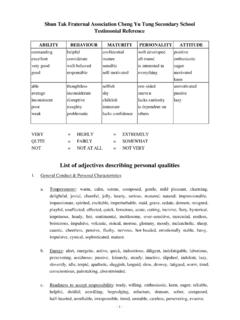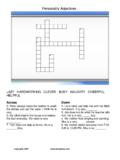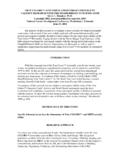Transcription of The OAD Survey - Taxonomy of General Traits
1 ORGANIZATION ANALYSIS AND DESIGN The OAD Survey - Taxonomy of General Traits 1. Introduction The OAD Survey (Organization Analysis and Design) is an adjective-based organization diagnostic, selection, and development instrument comprising two matched questionnaires. Each questionnaire contains 110 identical adjectives. For the first set of 110 adjectives, respondents are asked to check those words which best describe themselves. For the second set of 110 items, respondents are asked to check those words that describe how they must behave in their current (or previous) job. Both questionnaires comprise six distinct scales, defined below: Assertiveness/Autonomy: independence, need for control, self-confidence, resourcefulness; Extraversion: degree of social and people orientation guiding a person s behavior; Patience: degree to which individual needs system and predictability, degree of patience; Detail-orientation: concern for correctness, orderliness and structure, including sense of duty; Emotional Control: extent to which individual exercises control over emotions and actions; Creativity: degree of inventiveness and originality of thinking.
2 In addition, scores on the first four scales (Assertiveness/Autonomy, Extraversion, Patience and Detail-orientation) are summed to produce a cumulative score, termed Versatility Level . Versatility Level is regarded as an indicator of behavioral flexibility, with higher scores indicating more flexible individuals who are willing to step outside of their comfort zone and who are better equipped to bounce back following periods of insecurity or stress. Each of the six principal scale scores is obtained by summing the number of checked items for that particular scale. This scale score is standardized by comparison with the total US dataset (N=234) and conversion to percentile score. Percentile scores are plotted on a website-generated graph according to decile position (ranging from 0-10).
3 The Versatility Level score is not standardized but is reported as the numerical sum of the A, E, P, and D words checked, as appears in Figure 1, below: 1 Figure 1: Example OAD (Trait) output graph 0 1 2 3 4 5 6 7 8 9 10 A E P D VL= EC CR I EC CR Figure 1 demonstrates that the respondent reports a 9th decile on (A) Assertiveness/ Autonomy, a 7th decile on (E) Extraversion, a 2nd decile on (P) Patience and a 7th decile on (D) Detail-orientation. The position of the norm line or divider (represented by the I character) denotes the mean decile value on summing these four scale scores. The Versatility Level (VL) score is reported as the number of A, E, P, and D words checked.
4 The respondent also reports a 5th decile on Emotional Control (EC) and a 9th decile on (CR) Creativity. The OAD describes the first four scale scores in terms of their relative position when compared against each other, using a norm line as a marker of the midpoint of the distribution. The Emotional Control and Creativity scales are reported as decile scores only and are reported in isolation. Similar calculations are undertaken with the second (Perceived Job Behaviors) of OAD s two-part questionnaire, with obtained scores compared with the US dataset (N=234) in order to produce percentile and then decile scores. Scores are plotted on a similar graph to that shown above. The reader is then provided series of narrative outputs: Output graphs (similar to that shown above) for both Traits and Perceived Job Behaviors ; A summary of the individual s trait profile; A summary of potential motivating needs for that individual; A summary of perceived job behaviors.
5 These data are intended for use by the user in a number of ways: Use of OAD as one diagnostic for management and/or organization development activities; Use of OAD Traits and Perceived Job Behaviors results as a basis for individual development, by comparing the two sets of data. Where substantial differences in 2the profiles appear, it is likely that the individual perceives a need to make radical behavioral changes in order to perform his/her current role more effectively; Use of both sets of output to identify individuals who may feel under- or over-utilized in their present positions and to investigate causes; Use of the Perceived Job Behaviors output to gather data on a particular job role/position, particularly during the initial phase of a job analysis; Use of OAD Traits output alone as one variable in the recruitment/selection process, particularly in forming a basis for subsequent interview.
6 2. CONTENT VALIDITY Over the period 1987-1990, Michael Gray, managing partner of OAD LLC, a Boston-based consulting firm, developed, refined and validated the OAD Survey over four major administration sessions drawing on over 1,000 US participants. Based on over 20 years experience of consulting in the Human Resources field, Gray (a Quantitative Analysis from Syracuse University) resolved to develop an adjective-based instrument which was aimed to improve on existing personality instruments in the following areas: Speed of completion; Reducing error through use of adjective-anchored inventory; Providing an indication of the respondent s fit with their current job role in order to identify possible current and future problems for individuals, teams, and departments.
7 Gray based the development of his initial item pool on the research underpinning McRae and Costa s (1987) research into a five-factor model of personality, and on Cattell s extensive research into personality ( Cattell, Eber and Tatsuoka, 1970). Drawing on his own knowledge of the world of work, as well as on the above research, Gray developed a pool of around 250 adjectives, which he felt tapped into those elements of personality most critical to success at work. Having run various pilot sessions with colleagues to ensure accessibility and comprehensibility of items, and to ensure that the domains covered by the items were as comprehensive as possible, Gray undertook a four-year validation program of the OAD Survey .
8 This validation program involved four major administrations of the instrument to over 1,000 US respondents between 1987 and 1990 (with samples numbering 110, 289, 413 and 234 cases, evenly split for gender) and saw the original 250-strong item pool reduced to 110 items through iterative factor and item analysis. A construct validation exercise during this period also saw the OAD administered concurrently with the 16-PF instrument to explore relationships between component scales. The six-factor instrument that emerged in 1990 had thus been derived on a largely empirical basis from extensive factor and item analysis, with a sound basis in personal experience and in the published work of major personality theorists such as Cattell and Costa and McRae.
9 While relationships between the six OAD (Trait) factors (see Introduction above) and those included in Cattell s 16-PF series, and Costa and McRae s NEO series are apparent (both intuitively and statistically see Section 4, below, for details on the 3statistical relationships between OAD s and the 16-PF instruments component scales), Gray incorporated an additional scale, Versatility Level , rarely seen in personality research. The Versatility Level scale was calculated by simple summation of the Assertiveness/Autonomy, Patience, Extraversion and Detail-orientation scales and was intended to provide an overall indication of the behavioral flexibility and General activity level exhibited by each respondent.
10 Based largely on his own experience of work, Gray believed that the level of Versatility exhibited by the individual could have a significant effect on experienced stress at work, acting as a buffer or coping mechanism when the individual was required to undergo a period of transition or insecurity. This proposition has been researched by Gray on a small scale, using a stress indicator measure, with some encouraging results (see Section for more details). 3. RELIABILITY Internal consistency reliability analyzes were carried out with the US dataset (N=234) using both Cronbach s alpha criterion and corrected split-half reliability estimates. Results appear below. Table 1: Internal consistency reliability estimates for the six principal scales of OAD Traits for US (n= 234) TRAIT Number of items Sample size (N) Cronbach s Alpha Corrected Split-half Assertiveness 17 234.



